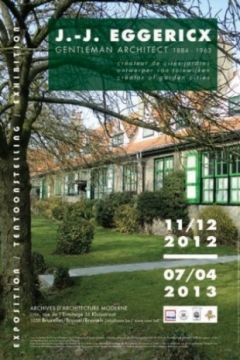The Archives d’Architecture Moderne are exhibiting the archives of Brussels architect Jean-Jules Eggerickx (1894 – 1963).The architect became known to the general public through the construction of the garden cities of Le Logis and Le Floréal at Watermael-Boisfort in Brussels. Of all the great 20th century architects, only the professional archives of Eggerickx were still in the family’s keeping and therefore at risk of being dispersed. The King Baudouin Foundation purchased the archives in 2010 and donated them to the Archives d’Architecture Moderne, thus safeguarding the memory of one of the leading figures of Belgian modernist architecture, alongside Huib Hoste, Louis-Herman De Koninck and Victor Bourgeois. The AAM will draw up an inventory and conserve and study the hundreds of documents in these archives over the coming years.
Architect, town planner and redeveloper, Eggerickx was a prolific creator. He returned to Belgium in 1919 after his exile in England with a special interest in the relationship between architecture and nature. Socially very committed, he pioneered collective housing that provided greater domestic comfort. His architecture, with its rigorous pragmatism and striking horizontal composition, served as a model for numerous colleagues and construction companies.
His work includes private houses such as the one commissioned by Claire Petrucci-Verwée, which was luxuriously furnished with Ruhlmahnn and Dominique furniture and fabrics designed by Raoul Dufy. Just for the anecdote, it was for Claire Petrucci that Henry van de Velde created the ring acquired by the Léon Courtin-Marcelle Bouché Fund.
Eggerickx also contributed to designing the first modern apartment blocks, including the twin towers of the Square Meeûs in the Quartier Léopold, which lent a certain magnitude to the neighbourhood. As a famous town planner he was also involved in urban development. Ostend chose him as consultant town planner for its reconstruction after the Second World War. In 1937, Eggerickx was awarded the Grand Prix of the Jury at the Paris World Fair for his Belgian pavilion located at the foot of the celebrated Eiffel Tower.
For a while, Eggerickx was close to Henry van de Velde, who in 1928 invited Eggerickx to teach at La Cambre where he remained rather outspoken, notably pleading for modern buildings to be integrated into the environment.
At the Rue de l’Ermitage, plans and elevations in watercolours, drawings in Indian ink and documents and photos of the period invite us to survey the highlights of Jean-Jules Eggerickx’s career.
Under the direction of Maurice Culot, and published by CFC, a group of art historians, town planners and architects has put together a remarkable compilation of documents entitled: J.J. Eggerickx (1884-1963). Gentleman architecte. Créateur de cités-jardins.
Practical information:
Archives d’Architecture Moderne
CIVA, Rue de l’Ermitage 55, 1050 Brussels
From 11 December 2012 to 7 April 2013
Tuesday to Friday from 12h to 18h
Saturday and Sunday from 10h30 to 18h
